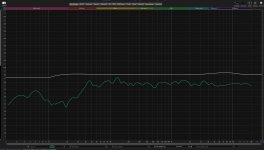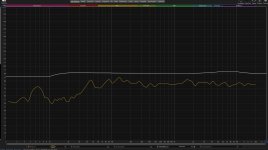Objective: I am looking to a) measure the components on the 2-way crossover of the Tangent Acoustic RS2 speakers I have and b) duplicate the crossover to build a new speaker with the same drivers (T27/ Audax HD20 B25J).
Current Plan:
a) Map out the circuit with a continuity tester
b) Identify bands on resistors/markings on Caps for ratings
c) Use an LCR meter to measure and confirm labled vs actual
d) Establish the delta and list components that need to be replaced in the old crossover.
e) Purchase components to re-store old cross over + build a new crossover.
f) Learn how to solder and build it out.
and build it out.
Current Roadblock: Purchasing a LCR meter that allows me to measure all components. Hence this thread.
I am considering the Tenma 72-10465 and the EXTECH LCR200.
Reason: Budget, and I see the EXTECH supports 5 different test frequencies vs the 1 on the Tenma. I am hoping for accurate readings on the 3 inductors since they can be hard to measure (is my understanding)/can influence the sound heavily if not duplicated correctly.
Seeking feedback from folks and their experiences with rebuilding/duplicating a crossover. Thank you!
Current Plan:
a) Map out the circuit with a continuity tester
b) Identify bands on resistors/markings on Caps for ratings
c) Use an LCR meter to measure and confirm labled vs actual
d) Establish the delta and list components that need to be replaced in the old crossover.
e) Purchase components to re-store old cross over + build a new crossover.
f) Learn how to solder
Current Roadblock: Purchasing a LCR meter that allows me to measure all components. Hence this thread.
I am considering the Tenma 72-10465 and the EXTECH LCR200.
Reason: Budget, and I see the EXTECH supports 5 different test frequencies vs the 1 on the Tenma. I am hoping for accurate readings on the 3 inductors since they can be hard to measure (is my understanding)/can influence the sound heavily if not duplicated correctly.
Seeking feedback from folks and their experiences with rebuilding/duplicating a crossover. Thank you!
If I didn't have any test equipment at all and I intended to continue in this hobby and build/fix things, I would invest in a multimeter, an audio signal generator, and an oscilloscope. With these pieces of equipment, along with some learning, and some calculators on the web, capacitance and inductance can be measured indirectly. The good thing is, these days, it would not cost much to acquire this gear.
Along with a good soldering iron, these basic test equipment will be very valuable in testing and troubleshooting future projects.
Another option is a computer with soundcard and software, although I find using test equipment is more convenient than the computer/software approach.
Along with a good soldering iron, these basic test equipment will be very valuable in testing and troubleshooting future projects.
Another option is a computer with soundcard and software, although I find using test equipment is more convenient than the computer/software approach.
If I didn't have any test equipment at all and I intended to continue in this hobby and build/fix things, I would invest in a multimeter, an audio signal generator, and an oscilloscope. With these pieces of equipment, along with some learning, and some calculators on the web, capacitance and inductance can be measured indirectly. The good thing is, these days, it would not cost much to acquire this gear.
Along with a good soldering iron, these basic test equipment will be very valuable in testing and troubleshooting future projects.
Another option is a computer with soundcard and software, although I find using test equipment is more convenient than the computer/software approach.
I am covered on the PC/soundcard option. But this tool will be specific for this project.
I don’t realistically foresee myself working additional projects since my amp/dac are COTS solutions (HTA200 and Topping E30 II). I will probably invest in a CD player for audio CDs.
Something that let’s me measure the components would be great. Open to used options as well
Thanks for that insight pinholer. I looked up the method. I think I'll stick to a LCR meter to measure the inductors and capacitors. Usually such trials require multiple measurements, and in the interest of time I'd stick to a tool rather than a compute method that would require setup on PC + hookup to speaker. Thank you though. I did learn something new!
For measuring components typically found in a passive crossover nothing beats this:
Dayton Audio DATS V3
Most standard VOM's can't accurately measure small value resistors, inductors and large capacitors as well as it does...and as an added bonus it measures speaker parameters too!
Mike
Dayton Audio DATS V3
Most standard VOM's can't accurately measure small value resistors, inductors and large capacitors as well as it does...and as an added bonus it measures speaker parameters too!
Mike
Michael, this is fantastic. Not only will this allow me to measure the L and C, but also compare the drivers I have on hand vs the replacement drivers I have obtained! Fantastic. Thank you. Problem 1 solved.
Next update in a week or so when I run my first freq. sweeps and gather baseline data from the existing RS2 speakers.
Next update in a week or so when I run my first freq. sweeps and gather baseline data from the existing RS2 speakers.
Ran my first measurements in REW yesterday night.
Setup: Umik-1
Running off PC
Amplifier: Dayton Audio HTA20 (20W/ch, pretty clean amplifier for the price (Sub $150).
Cables: Audtek 6'
The microphone was mounted on a dedicate microphone stand and I eyeballed the distance and center for now.
Extremely surprised at the results after 1/6th octave smoothing. For speakers that are over 40 years old.
Setup: Umik-1
Running off PC
Amplifier: Dayton Audio HTA20 (20W/ch, pretty clean amplifier for the price (Sub $150).
Cables: Audtek 6'
The microphone was mounted on a dedicate microphone stand and I eyeballed the distance and center for now.
Extremely surprised at the results after 1/6th octave smoothing. For speakers that are over 40 years old.
Attachments
- Home
- Design & Build
- Equipment & Tools
- Seeking: Budget LCR meter to measure unknown Crossover (Tangent Acoustics RS2)

